Marijuana Mushrooms: Virtually everyone who grows or has grown cannabis has ever had to deal with the unfortunate presence of fungi. The consequences of having these organisms on your crop can be disastrous and if we do not take action in time, we risk losing everything we have worked so hard for.

In this article we will explain what fungi are and make a small introduction to the most common fungi that can affect our crop, how to combat them and prevent their appearance.
What are fungi?
Fungi are very primitive eukaryotic organisms that belong to the fungi kingdom. They reproduce themselves through spores and usually appear in warm, dark and humid places.
The fungal spores are in the environment until they find the ideal conditions to grow and develop. The problem is that the development conditions of fungi are very similar to those of plants, darkness, warmth and humidity, so it is not surprising that in the crops proliferate this type of living beings.
There are some fungi able to reproduce very quickly, in just a few days we can have all our crop infected by these unpleasant guests. It makes necessary to take a series of preventive measures to prevent its appearance. If prevention doesn’t work and fungi attack our crop, early detection and rapid action to eliminate them are essential to avoid problems and save our crop.
Prevention measures.
Cleaning:
Cleaning is essential when carrying out a crop. A clean and disinfected place will not only help to avoid the presence of fungi, but also other harmful pests that affect our cannabis plants such as the red spider or whitefly.
Before indoor cultivation, it is important that the area used for indoor cultivation is properly disinfected with bleach. Clean utensils should also be used, and a constant hygiene of the place should be maintained throughout the process, eliminating dead leaves and any residual waste. Once the crop is finished, we must clean and disinfect the space again, so it is free of any organism.
It is also important not to use rainwater directly as rainwater may contain debris that could infect our plants.
Climate control.
The right conditions to prevent fungi appearing requires good ventilation in our growing area and controlling humidity.
The room where it is grown must be permanently ventilated, preventing stagnant air from remaining for a long time and constantly renewing it.
We must also control the humidity that should not exceed 50%, especially in the flowering phase. To do this, we can use dehumidifiers that absorb the humidity of the environment preventing it from triggering.
Clearly, these parameters are much easier to control in indoor crops. Outdoors, it is more difficult to control certain factors such as humidity or air circulation, but we can maintain adequate hygiene. Depending on the regions in which we live, we must avoid planting too late varieties that may be affected by autumn rains.
We can also use fungicides that help in the prevention of fungi such as Propolix, made from propolis, a natural substance used by bees that acts as an antiseptic, fungicide and antiviral.
If prevention measures have not worked and our crop has been affected by any fungus, here is a list of the most common, how to detect and treat them.
BOTRYTIS.
Gray botrytis or grey mould is a pathogenic fungus especially common in indoor and outdoor crops harvested from October.
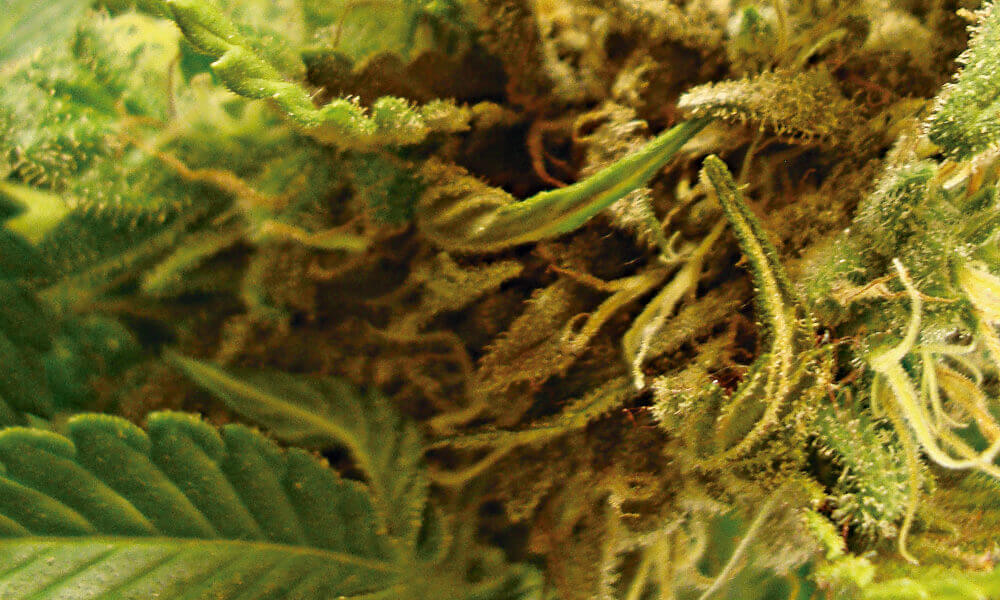
It mainly affects buds in the flowering phase due to high humidity and lack of ventilation.
We can easily detect botrytis because the buds and other parts of the plant such as the stems and leaves turn grey or brown. The buds are dry and decompose when you touch them.
This fungus causes necrosis of the parts it affects and reproduces extremely quickly.
It is very common and very harmful because if not controlled in time, it completely destroys the plant and our harvest.
This fungus can affect buds during the drying and curing phase, so it is very important to control the air during this stage as well.
Treatment and solutions:
The best treatment for Botrytis is prevention, as it usually affects plants in the flowering stage and no chemicals can be used.
Extreme prevention measures are essential and be especially vigilant when cultivating indica varieties with denser, more compact buds.
Good ventilation, a clean area, disinfected space and humidity below 50% are the key to preventing the development of this fungus.
When we detect Botrytis in our plants we must cut the affected part and eliminate it. These damaged parts cannot be used under any circumstances, not even for extractions because Botrytis is very harmful to our health.
As a preventative we can use fungicides such as propolis and if we cannot control the infection and the plants are not yet ready to cut, we can use cycle accelerants that allow us to harvest earlier as Ripen.
OÍDIO.
Oídio is also one of the most common fungi you can find in cannabis crops. It is quite easy to detect because it is manifested in the form of white powder, usually in the leaf blade, which gradually extends to the stem and flowers. When Oídio is widespread it causes yellowing of the leaves and defoliation.

It is a fungus that likes humidity and high temperature, settles on the leaves and with its hyphas absorbs nutrients from the plant.
It is not a particularly harmful fungus, but it is very common and if it is not controlled in time and reaches the buds, they should be discarded because, like the buds infected with Botrytis, cannot be consumed in any way.
Treatment and solutions:
The best thing we can do with powdery mildew is to prevent it from appearing, trying to avoid the conditions propitious for its appearance (relative humidity and high temperatures, as well as sudden changes in temperature).
However, if we have not been able to prevent it from emerging, we can remove the infected parts, being careful not to spread the spores found in the leaves.
We can also use fungicides such as propolis and ponytail or sulphur.
If these methods do not work, we must use chemical fungicides to eliminate this annoying presence of our crops. If we are in an advanced flowering stage and cannot use chemicals, we should try to control the fungus and harvest as soon as possible before the buds are spread and rendered unusable..
MILDIU.
Mildew is a quite aggressive fungus that grows in places with temperatures below 26ºC and humidity above 50%. It can affect plants both in growth and flowering phase, although it has a predilection for young leaves.
The mildew appears in the form of yellowish and pale spots on the leaves and we can see white powder on the underside of leaves. When the disease is more advanced it causes leaf defoliation and later death.
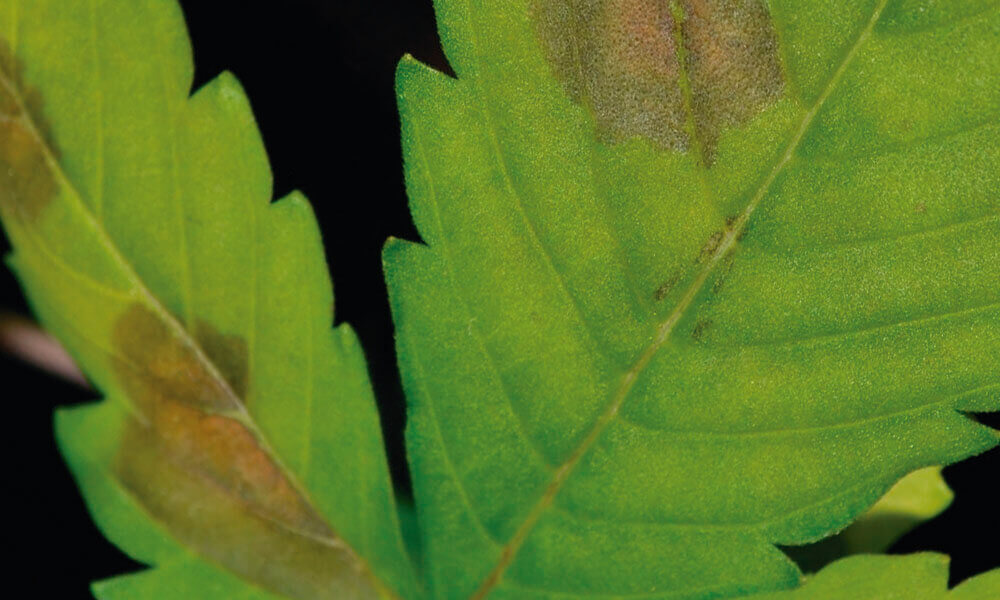
It spreads very quickly, being able to kill whole crops in few days, and it develops mainly from the crop’s remains.
Treatment and solutions:
The best method to treat mildew, as in all fungi and pests, is to avoid its appearance. It is a very aggressive fungus and if we detect its presence, means that the plant is already affected systemically.
It is essential the cleaning of the growing area and eliminate plant debris that encourage its appearance.
If our plants have been attacked by this fungus we must eliminate the leaves that are more infected, separate the plants and ventilate the room so the air circulates and is not spoiled.
We must avoid the environmental conditions that encourage the development of mildew: temperature below 26ºC, humidity and darkness.
We must also use products to eliminate fungus. For the treatment of mildew there are fungicides by contact and systemic that must be applied between 24-72h from infection.
We can also use sulphur to treat mildew but always with a temperature below 32 º C and a humidity of more than 50% to prevent damage to the foliage.
There are alternatives such as Bordeaux broth that has traditionally been used for the treatment of this fungus.
BOLD.
Tizne or bold is a fungus that appears from a sticky substance excreted by insects such as aphids or whiteflies. This mold-like substance is what causes this fungus to appear.

Blush can be detected with the naked eye as the leaves are covered with black spots. The attack of this mold causes that the plant has problems to perform photosynthesis. This entails development problems like slower growth, loss of vigour and reduced harvest.
Treatment and solutions:
The best treatment to eliminate this fungus is to eradicate the pest causing its appearance. Once we have eradicated insects that excrete molasses, mold will die and we will prevent its spread.
We will have to wash the remains of molasses and fungus with soap, we will not recover the affected brunches, but we will stop their propagation.
FUSARIUM.
The fusarium is a fungus with great destructive potential. It is most common in indoor crops and in greenhouses where the temperature is higher.
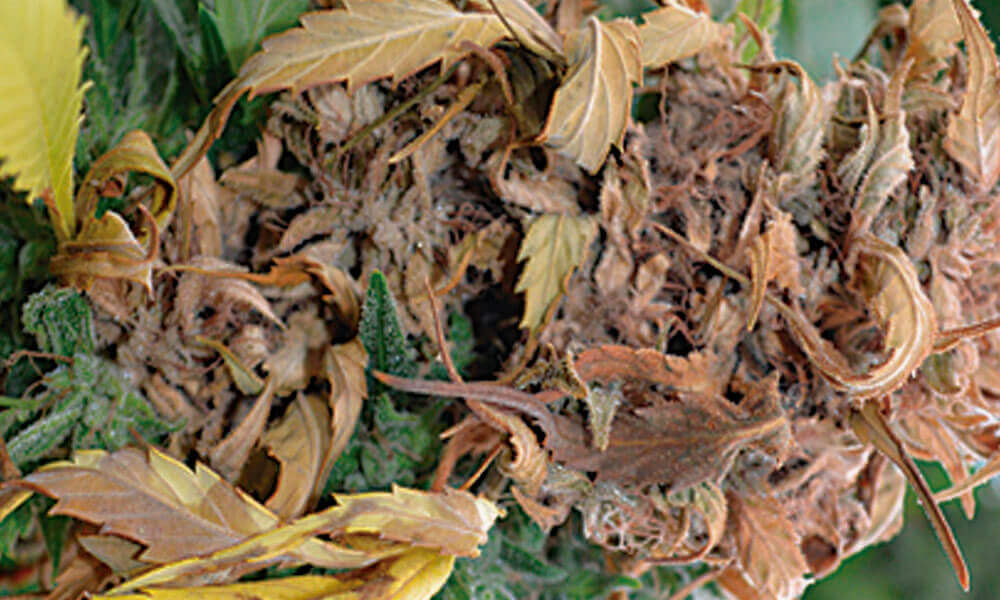
This fungus is usually transmitted to the plant through water, substrate, infected utensils or cuttings.
This fungus affects the plant’s xylem, a plant tissue that carries fluids, blocking the flow of nutrients and severely affecting the plant.
It begins with the yellowing of the leaves of the lower part of the plant, then causes nerval chlorosis of the leaves, necrosis and defoliation, finally, the plant withers. This fungus may only partially affect the plant, depending on where it is introduced. It is a very fast process that destroys the life of plants in a fulminating way.
We can detect the fusarium fungus by observing the inside of the stems that will have turned reddish brown.
Treatment and solutions:
Once our plant has been infected with the fusarium fungus, no further treatment is possible. The only thing we can do is try to avoid the appearance, always maintaining maximum hygiene.
Always use sterile instruments, maintain hygiene in clothes and hands, check irrigation water and substrate and avoid using cuttings that may be infected with fungi. Hygiene in the growing room is essential to prevent the proliferation of fusarium fungus and other pests and diseases.
ROOT ROT
Root rot is a fungus that, as its name indicates, affects the roots, causing them to pass from their characteristic white to light brown color, which gradually darkens as the disease progresses.
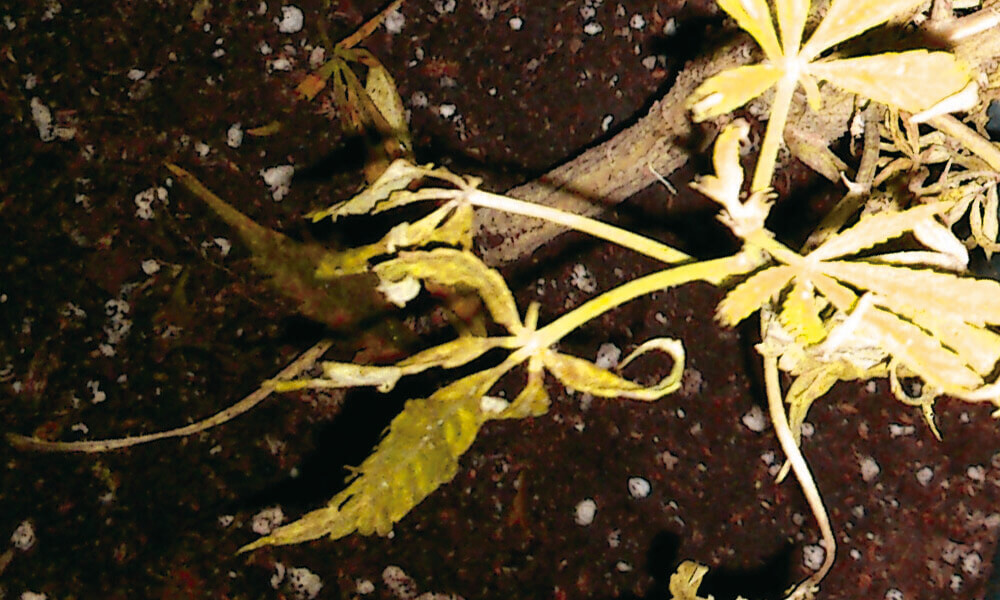
The symptoms are chlorosis and yellowing of the leaves, defoliation, withering, general weakening of the plant and finally, death.
It tends to appear due to excessive irrigation, poor drainage and the attack of small insects and other organisms that damage the roots and cause them to start rotting.
Treatment and solutions:
It is a difficult disease to treat, so the best thing we can do is to prevent it. Avoiding excess irrigation, stagnant water and poor drainage will help prevent the appearance of this fungus.
The use of thricoderms will also help protect our plants from these diseases.
VERTICILOSIS.
Verticilosis is a disease caused by Verticillium fungi that provoke symptoms in plants very similar to the Fusarium fungus, although it is less common.

As in fusariosis, the fungus obstructs the plant’s xylem, causing the flow of nutrients to be blocked and the plant not receiving food.
The main symptoms are withering of the plant, which can sometimes be only partial. If the stem is cut in half, as in fusariosis, we can see the inside of the stem reddish brown.
Treatment and solutions:
Once the plant is infected, it cannot be treated, so prevention is essential. We should avoid planting in the same soil where there has been a plant affected by this disease. Using new, sterile soil and always keeping the growing site clean and disinfected will help prevent its appearance.
ROYA.
It is a common fungus that has great destructive potential although, it can be treated and prevented from spreading.

This fungus mainly attacks the leaves and stems and can be identified by the appearance of small brown, reddish or yellowish bumps on the underside of the leaves; while yellowish spots appear on the bundle.
The favourable conditions for its appearance are high humidity and lack of ventilation. Outdoors, this type of fungus usually proliferates during the spring and autumn months when rainfall is most prevalent.
It spreads very quickly because the spores are carried by the wind and wait for the right conditions to start developing.
Treatment and solutions:
Most commonly, leaves that have already been affected cannot be treated although there are many systemic fungicides that can prevent the spread of the fungus.
Oidium and mildew treatments can be used or sulphur can also be used to treat Roya.
If the plant is quite affected, the best option is to remove it from the crop to prevent the fungus from affecting the rest. Obviously, the plants affected by Roya will see their growth and production diminished as they will have to use forces to produce new leaves again.
As always, the best method is prevention and hygiene of the growing space.
ESCLEROTINIA.
Sclorotinia is a fungus that appears in our plants in the form of white mycelium with a similar appearance to cotton, forming a hard and compact mass of dark color known as sclerotia. It usually appears on the stems and spreads to the roots. It causes the affected area to rot and leaves to wilt.
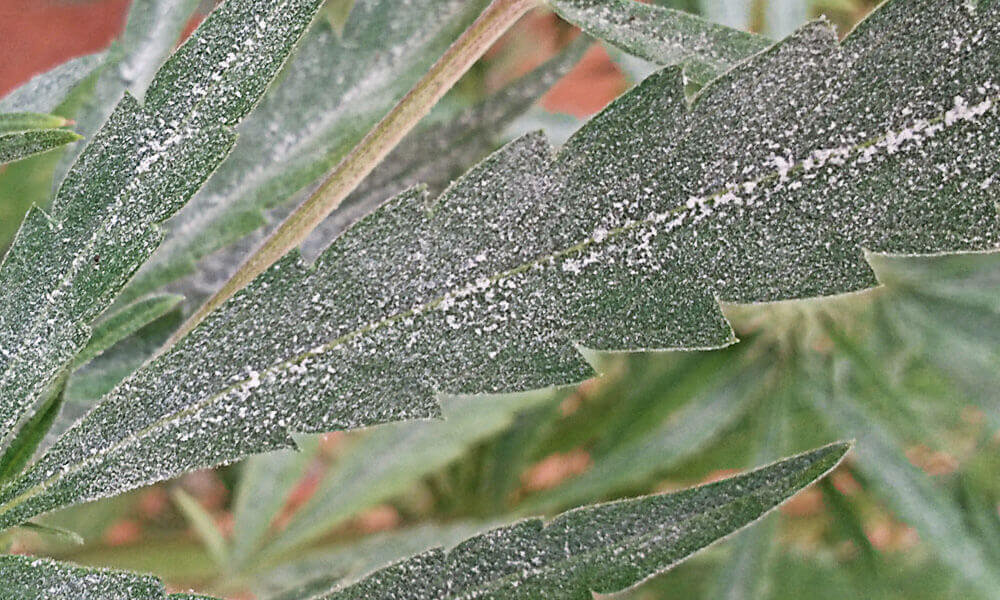
It usually occurs in environments with high relative humidity and high temperatures. Soils with excess nitrogen also favour the appearance of this fungus.
Treatment and solutions:
Systemic fungicides and treatments against powdery mildew can be used to treat sclerotinia, however, as with all fungi, it is best to avoid its occurrence.
Cleaning and hygiene of the place of cultivation, soil with good drainage, adequate ventilation and avoiding injuries that facilitate the penetration of fungus are good preventive measures.
If one of our plants has been affected by sclerotinia, the best option is to remove it from our crop to avoid the propagation of spores that may affect more specimens.
PYTHIUM.
It is a parasitic fungus that penetrates the plant through the roots, seriously affecting its vascular system and preventing the plant from receiving food correctly.
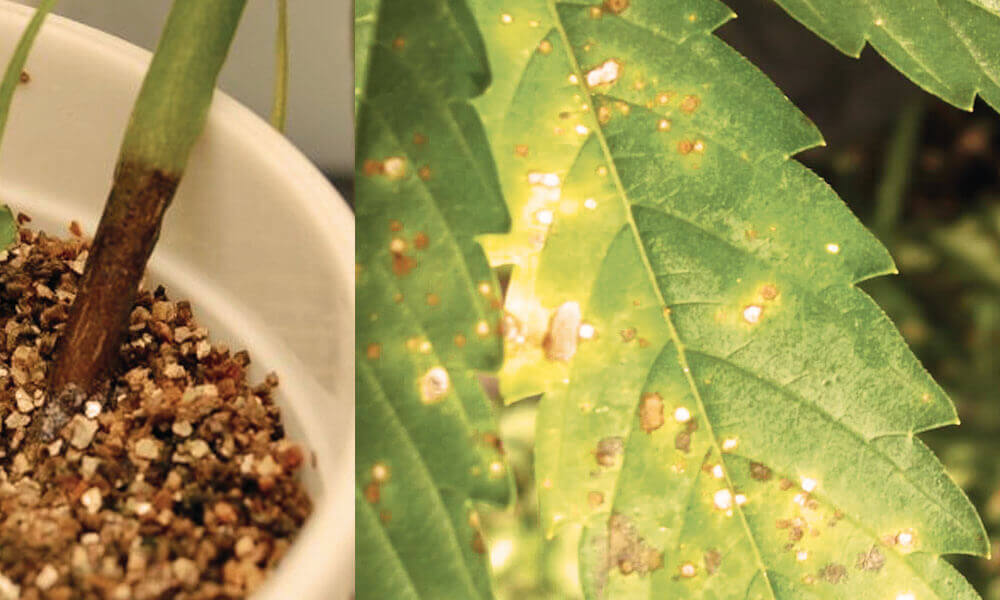
It mainly affects plants in the germination or seedling stage, stages in which they are much more vulnerable and in which the attack of this fungus causes its death.
It is possible to treat adult plants affected by Pythium but the attack of this fungus will harm the development of the plant and consequently the end result.
We can detect the attack of this fungus by observing the behavior of our plant. In adult specimens, the leaves acquire a weak aspect and begin to yellow and suffer necrosis, so it is common that we can confuse it with a nutritional deficiency. They also tend to roll inwards, if we look at the roots of the plant, these will have turned brown. When it affects seedlings and seeds in the germination phase. This fungus inevitably causes plant death and no treatment is possible. In seeds we will be able to detect the attack of this fungus because the seeds acquire a soft and viscous aspect and we will not be able to do anything to save them.
Pythium is a fungus that grows in environments with excessive humidity and temperatures between 20 and 30ºC.
Treatment and solutions:
The best treatment we can use for Pythium is to avoid its appearance. To do this, we will have to check the seedlings and cuttings frequently as they are the most affected. Keeping the growing area clean and disinfected is the solution to prevent this fungus from appearing. As well as using clean and sterilized instruments and clean water that does not come from an infected place.
There are also some fungicides on the market that may be administered through sprays or irrigation water.
ALTERNARIA.
Alternaria is a common fungus that besides affecting plants, it is also responsible for allergies in humans.
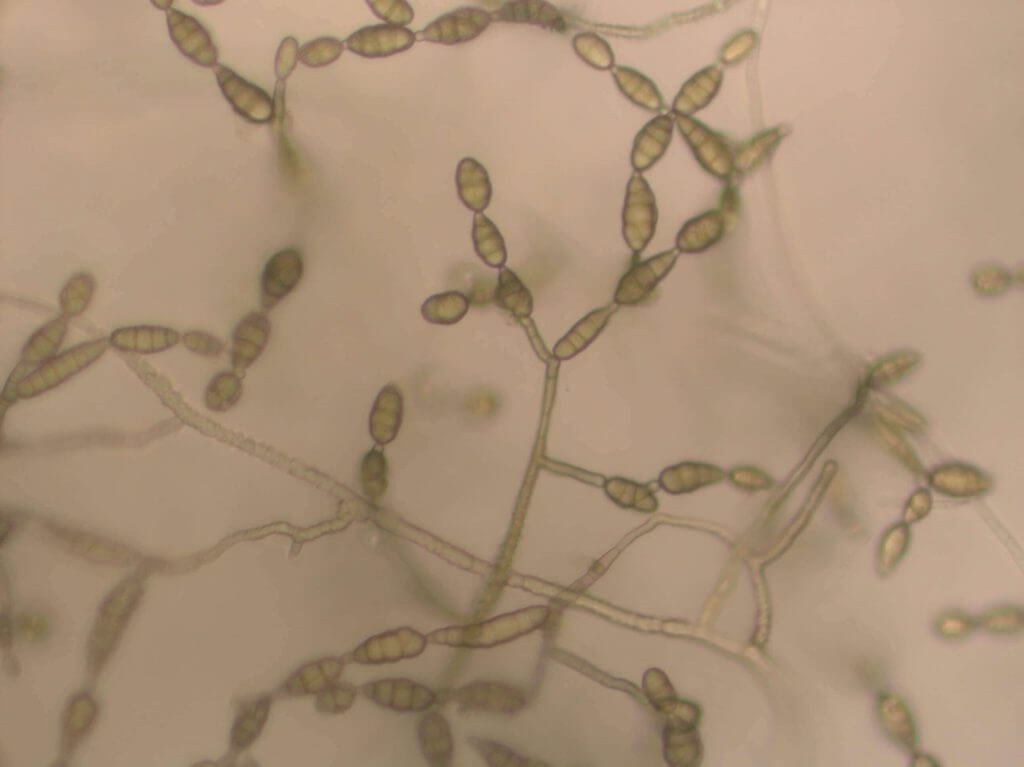
It is a fungus very present in the environment, whose spores are carried by the wind and proliferate in decomposing debris.
They usually affect the older leaves at first, in which spots appear in the shape of a brown circle and, around the stain, leaves turn yellow.
Although the alternaria spores are present all year round, they are favored by high humidity and temperature changes, so they appear more in the spring and autumn months.
Treatment and solutions:
There are some systemic fungicides that can help combat alternaria. To help prevent it, we should avoid sudden temperature changes, high relative humidity and keep the growing area clean and ventilated.
Some preventative drugs such as propolis or ponytail will help prevent the onset of this disease.
In conclusion, we could say that the best way to keep our plants healthy and get the most out of fungus is to avoid the appearance of fungi and other diseases. To do this, it is important that we keep our growing space always clean and disinfected and control the climate to try to avoid the appropriate conditions of development of these unpleasant guests.




Hey I have a problem with my plants. The plants are 4 weeks and couple days old. The tips of the leafs are turning brown it all started with the sucker leafs turning yellow. Also the lower stem is skinnier than the rest. I also have some white marks on the leafs. Help pls
What about fugis that develop in soil? I keep coming across a pail yellow fugi that starts as tiny balls resembling perlite. Until it accumulated and then resemble a yellow sponge embedded in the soil.
What’s the best way to stop leaf septoria
Any product that has maneb, mancozeb, or chlorothalonil in the composition.